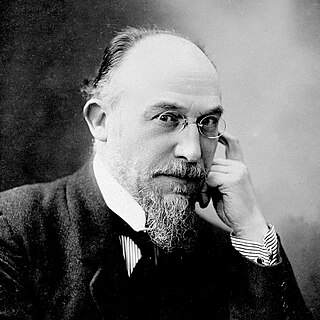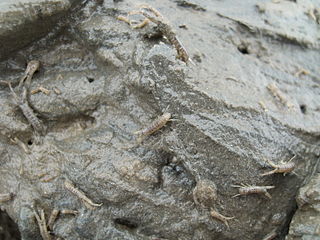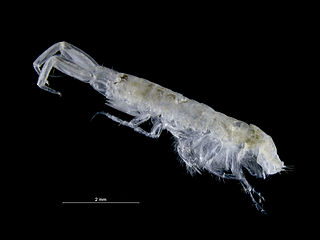
Embryons desséchés is a piano composition by Erik Satie, composed in the summer of 1913. The composition consists of three little movements, each taking about two to three minutes to play.

The black crappie is a freshwater fish found in North America, one of the two types of crappies. It is very similar to the white crappie in size, shape, and habits, except that it is darker, with a pattern of black spots.

Corophiidae is a family of amphipods, containing the following genera:

White sturgeon is a species of sturgeon in the family Acipenseridae of the order Acipenseriformes. They are an anadromous fish species ranging in the Eastern Pacific; from the Gulf of Alaska to Monterey, California. However, some are landlocked in the Columbia River Drainage, Montana, and Lake Shasta in California, with reported sightings in northern Baja California, Mexico.

The splittail, also called Sacramento splittail, is a cyprinid fish native to the low-elevation waters of the Central Valley in California. It was first described by William O. Ayres in 1854. It is the sole living member of its genus, the Clear Lake splittail P. ciscoides having become extinct in the 1970s.

Corophium is a genus of the amphipod family Corophiidae. Formerly a much larger genus, many species have been transferred to segregate genera such as Monocorophium and Crassicorophium.

Corophium volutator is a species of amphipod crustacean in the family Corophiidae. It is found in mudflats of the northern Atlantic Ocean. It is native to the north-east Atlantic Ocean, and has been introduced to the north-west Atlantic.
Corophium arenarium is a small European amphipod crustacean of the family Corophiidae. It looks very similar to C. volutator.
Shepody Bay is a tidal embayment, an extension of the Bay of Fundy in New Brunswick, Canada, which consists of 77 square kilometres (30 sq mi) of open water and 40 km2 (15 sq mi) of mudflats, with 4 km2 (1.5 sq mi) of saline marsh on the west, and eroding sand and gravel beaches covering an area of approximately 1 km2 (0.39 sq mi) on the eastern shore. The intertidal mudflats "support internationally important numbers of the crustacean Corophium volutator, the principal food source for millions of fall migrating shorebirds".

Mary's Point is a 12 square kilometres (4.6 sq mi) wetland in Albert County, New Brunswick, Canada. It is at the head of the Bay of Fundy, just outside the small community of Harvey and approximately 40 km (25 mi) south of Moncton. Designated a Ramsar wetland of international importance on May 24, 1982, it is also part of the Fundy biosphere reserve established in 2007, which also contains the Shepody Bay wetland. It was also the first Canadian site in the Western Hemisphere Shorebird Reserve, as part of the Bay of Fundy Hemisphere Shorebird Reserve. It is within the Shepody Bay National Wildlife Area, which is administered by the Canadian Wildlife Service.

Sea foam, ocean foam, beach foam, or spume is a type of foam created by the agitation of seawater, particularly when it contains higher concentrations of dissolved organic matter derived from sources such as the offshore breakdown of algal blooms. These compounds can act as surfactants or foaming agents. As the seawater is churned by breaking waves in the surf zone adjacent to the shore, the surfactants under these turbulent conditions trap air, forming persistent bubbles that stick to each other through surface tension.

Monocorophium is a genus of amphipod crustaceans.
Crassicorophium crassicorne is a species of amphipod crustacean. It lives in shallow subtidal muddy sand and may grow up to 5 millimetres (0.20 in) long. C. crassicorne occurs on American and European coasts from Norway to the Black Sea.
Medicorophium affine is a species of amphipod crustacean. It is a small species which burrows in bottom sediments, between 10 and 80 metres deep. It occurs on coasts of Northern Europe.
Chelicorophium curvispinum is a species of amphipod crustacean. It lives in salt, brackish and fresh water, and may reach 6 millimetres (0.24 in) in length. It occurs in the Caspian Sea, the Black Sea and adjoining rivers, and in river systems emptying into the southern Baltic and North Sea.

Apocorophium lacustre is a species of amphipod crustacean. It lives in nearly fresh water; it is white and up to 6 mm long. It occurs mainly on the Atlantic coast of North America, the North Sea and the Baltic.
Sinocorophium heteroceratum is a species of amphipod crustacean. It naturally occurs in Southeast Asia, but was introduced to San Francisco Bay, probably carried in the ballast water of cargo ships.
Maritrema subdolum is a species of parasitic fluke found in the Wadden Sea. It is related to the New Zealand species Maritrema novaezealandensis, and like its New Zealand relative, Maritrema subdolum infects local amphipods, in this case, Corophium volutator and Corophium arenarium. The cercariae of M. subdolum emerge from the first intermediate host, a gastropod of the genus Hydrobia for example, and seek out the next host, a crustacean. There the cercariae develop into metacercariae and form metacercarial cysts of different sizes.
Ramellogammarus similimanus is a crustacean species in the family Anisogammaridae. Because this amphipod only resides in the Portland metropolitan area, in Oregon, United States, it has been given the common name "Stumptown scud."









